Favorite Pools: A Whale, World Records And Olympic Light And Darkness At The London Aquatics Centre
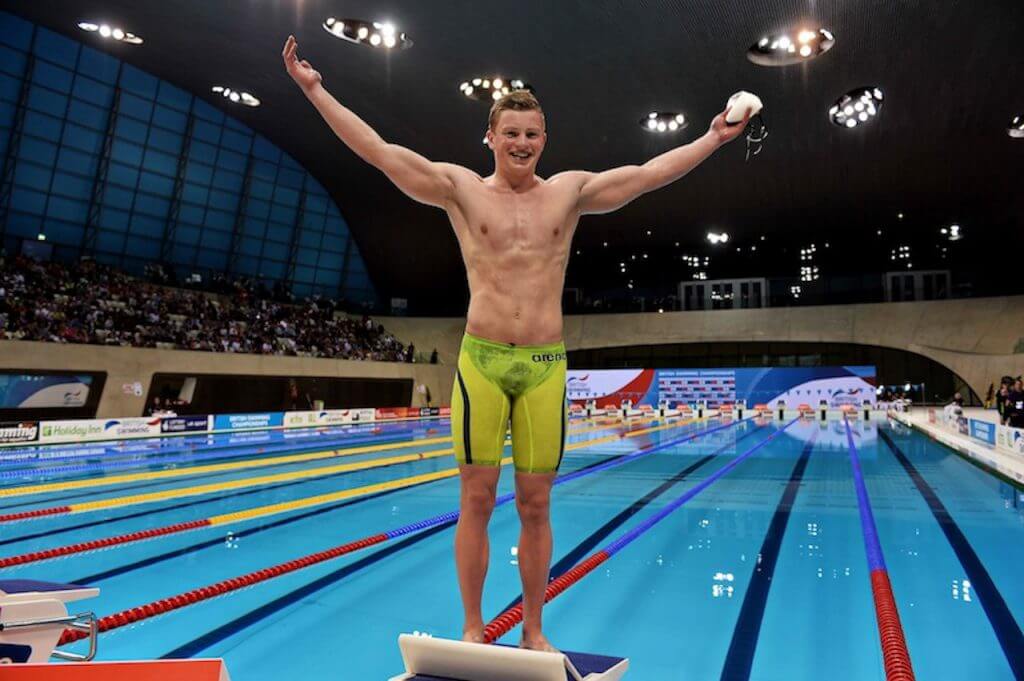
I’ll be honest. When I first saw the London Aquatics Centre in London I was puzzled. Impressed with its size and grandeur, yes. But puzzled.
Why the bewilderment? Well, I didn’t really ‘get’ what the design was meant to signify but for me it resembled a whale.
All undulation and smooth curves, a whale also seemed appropriate given its place in water.
According to the website of designer Zaha Hadid though, the Aquatics Centre is “a concept inspired by the geometry of water in motion……an undulating roof sweeps up as a wave.”
Whale, wave, whatever – it took some absorbing, the water the bluest of blue.
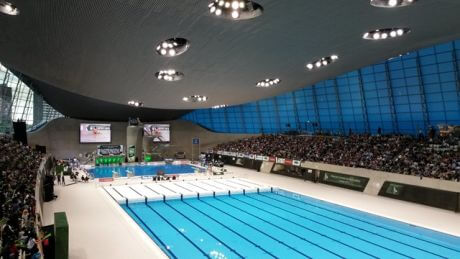
Photo Courtesy: londonaquaticscentre.org
My first visit to the London Aquatics Centre was for the British trials for the 2012 Olympics, hundreds of hopefuls taking their places in the inaugural swimming competition to be held at the venue in the regenerated Stratford area of East London.
As with every Olympic trials there were the highest of highs and lowest of lows with the extremes of emotion running parallel, sport crystallised in one moment.
But this time there was the knowledge hanging in the air that it was a once-in-a-lifetime chance to compete at a home Games.
Becky Adlington was breathless in the mixed zone after clocking 8:18.54 in the 800 free, the defence of her title safely booked along with the 400.
Fran Halsall was tickled pink as she won the 100 free in an eye-catching suit before she scorched to 50 free victory in 24.13 before telling all about her first pets, goldfish Inge and Thorpey, named after Inge de Bruijn and Ian Thorpe, the pair the holders of a combined nine Olympic titles.
There were tears as Siobhan O’Connor – who had made her senior British debut at the 2011 World Championships – failed to progress in the 200IM although she booked her slot at the second-stage trials in Sheffield later in June.
And Kris Gilchrist, the 2006 European bronze medallist, was dignity personified while being interviewed on poolside after coming third over 200m breaststroke, his Olympic dream extinguished.
Emotion hung heavy everywhere and while usually there is a feeling of slight deflation at the end of an event, this time there was also an anticipation. After all, this was the starter ahead of the main course as the Olympics became very real.
Returning that July, the London Aquatics Centre resembled a cathedral to swimming, the temporary wings that swelled the capacity to 17,500 vaulting skywards to the heavens.
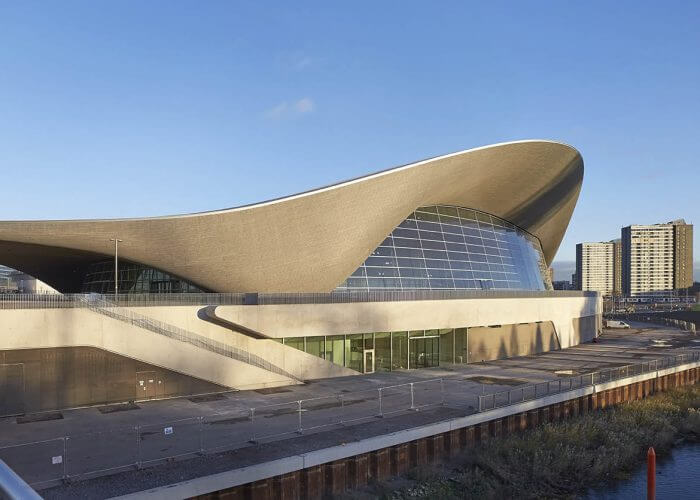
Photo Courtesy: zaha-hadid.com
The glare of the TV lights. The crowds. The numbers working at the pool be they logistics, security, volunteers or broadcasters. The mixed zone, where the press interview the swimmers after their races, was on a completely different scale
Each day we would walk from the London Underground station, up the escalator and into the outside area of the Westfield Shopping Centre.
From there we just had to follow our ears as the Games Makers sang and cheered as they corralled and directed the crowds. London – not known for being the friendliest of cities (sorry Londoners!) – transformed.
We had the privilege of witnessing history being made. And, of course, it was Michael Phelps’ final competition.
On the first day of competition there was a shudder as 2008 triple medallist Laszlo Cseh failed to make the 400IM final, locked out by one place as he admittedly tracked Phelps rather than execute his own race. Instead it was the American who took the eighth and final spot by 0.07secs.
Devastation is a word that is over-used in my opinion but it was certainly apt for the Hungarian who has never again taken on the 400IM in serious competition.
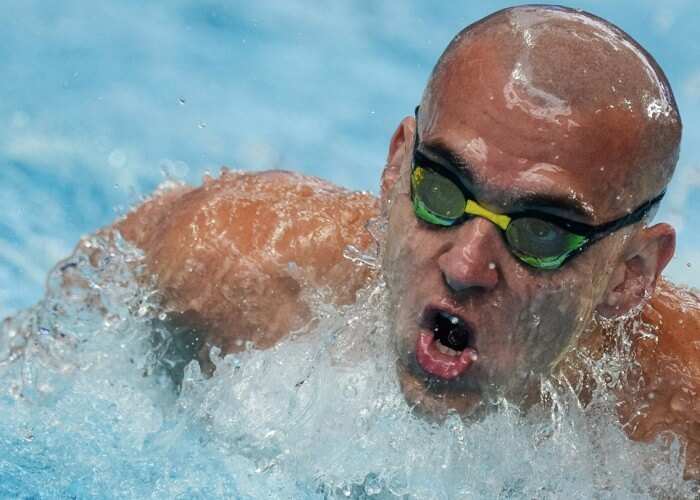
Photo Courtesy: R-Sport / MIA Rossiya Segodnya
Speaking to me at the 2014 European Championships in Berlin, Germany, the memory weighed heavily on Cseh, who appeared haunted almost, saying:
“It was the biggest mistake of my career.
“In London we swam next to each other in the heats. I didn’t make the final. I didn’t think about Michael not being in good shape and not so fast.”
Phelps came fourth that night as USA team-mate Ryan Lochte took the title, all fake gold grills on his teeth, 130 pairs of shoes and, according to the New York Times, “the personality of a golden labrador.”
There were too many memorable performances in the water that week to highlight each one but two South Africans commanded the spotlight in their own way.
Cameron van der Burgh became the first men’s Olympic swimming champion when he won the 100m breaststroke in a world record 58.46, lying back on the lane rope, hands wrapped on his head which rested on the wall, a huge smile on his face.
London was Phelps’ farewell and he was seeking the three-peat in the 200 fly. All seemed to be going to script until those final few metres as the green cap of Chad Le Clos relentlessly closed in. At the touch all eyes turned to the scoreboard when a split-second of silence was followed by a gasp which reverberated around the pool.
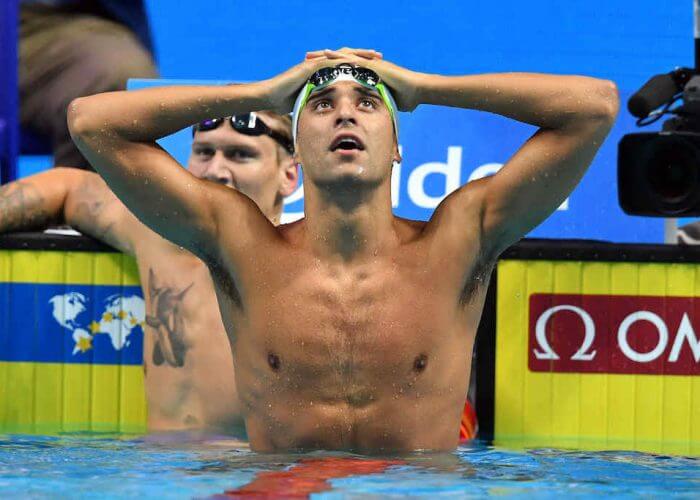
Photo Courtesy: Gian Mattia D’Alberto /LaPresse
In the pool Le Clos hoisted himself on the lane rope, beating the water one second, arms aloft the next, his hands clasping his head, open-mouthed disbelief on his face. In the stands Bert Le Clos bellowed his pride to the world – “my beautiful boy”.
There was disbelief on the face of Phelps too whose shock was still apparent on the podium, a grimace on his face.
Phelps became the most decorated Olympian in history after claiming four gold and two silver medals to take his total to 22.
It was not a great meet for the British with two bronze medals from Adlington at the dawn of the era of Katie Ledecky, an Olympic champion at 15 over 800m freestyle. Adlington finished a fantastic Olympic career with four medals from four races, her two golds from Beijing among the finest British efforts at any Games. In London, there was also a fine silver for Michael Jamieson in the 200m breaststroke.
The reception for the home team was spine-tingling but performance director Michael Scott left the London Aquatics Centre with criticism and questions ringing in his ears.
I returned weeks later for the Paralympics and it was a different experience. The feeling in the stands day after day was joyous and celebratory, at times raucous.
Then it was all over and I didn’t return until late 2014. By then the London Aquatics Centre had reopened for public use and those soaring stands had gone. No mixed zone. No miles of cables to trip over. No thronging crowds. It made me wonder if places where dreams are realised and dashed absorb some of that emotion and history. Invisible to the eye but a silent witness, a historian.
I wanted to go and swim there. Down the stairs, into the changing rooms and out on to poolside. And in…….
Now the stands had gone, there were two vast windows on either side, allowing the light to shine in on the water, to flood it with light. A feeling of vast space.
Swimming there was like floating, gliding on top of the water.
A diving session was in progress. “There’s Tom,” said a voice. We all turned and there was Tom Daley on the top board, the same one from which he won Olympic bronze.
In the second pool there were excited schoolchildren splashing about, loving the water and learning. Grassroots and elite side by side, what sport should be about surely.
I returned in April 2015 for the British trials for the World Championships in July that year. Where there had been 17,500 people looking on in July 2012, there was a smattering of clubs, family, friends and fans.
But those fortunate few would witness history being made.
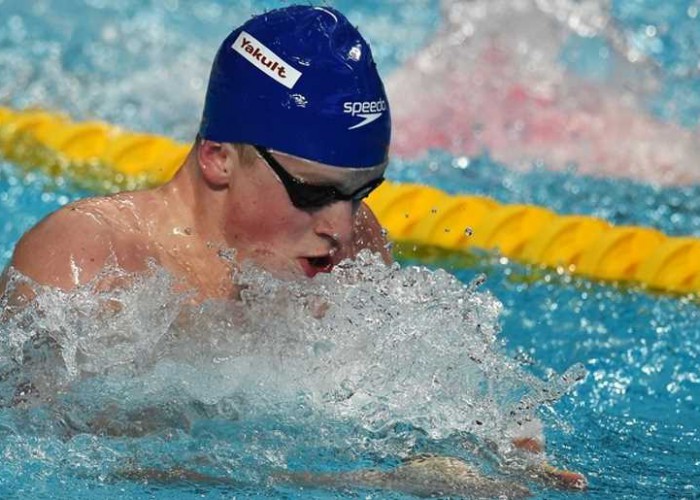
Photo Courtesy: R-Sport / MIA Rossiya Segodnya
On 17 April Commonwealth champion Adam Peaty strode to the blocks for the 100m breaststroke final at a time when British swimmers were still purging the 2012 ghosts of The London Aquatics Centre.
Swimming in the same lane four in which Van der Burgh had broken the world record in July 2012, Peaty went out in 27.04 – 0.03secs under WR pace.
There was an audible intake of breath by all present and a knowledge as Peaty streaked away that history was being written in front of our eyes.
And then some. Peaty touched in 57.92 – the first man under 58 seconds. It was shuddering. Ghost-busting. He stood on the blocks in his lime-green suit for photos, his arms outstretched either side as if to embrace what would be coming his way and a huge smile on his face. As our editor, Craig Lord, noted that date, he had travelled over 100m breaststroke at the pace of Tarzan, Johnny Weissmuller, who took the 100m freestyle World record below 58sec in 1924.
It remains one of my most special moments in sport.
Advertising: Shop At Swim360



